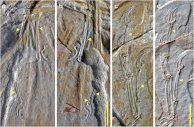Ostromia
This article or section is in a state of significant expansion or restructuring. You are welcome to assist in its construction by editing it as well. If this article or section has not been edited in several days, please remove this template. If you are the editor who added this template and you are actively editing, please be sure to replace this template with {{in use}} during the active editing session. Click on the link for template parameters to use.
This article was last edited by MBelzer (talk | contribs) 6 years ago. (Update timer) |
| Ostromia Temporal range:
| |
|---|---|

| |
| Slabs of the type and only specimen | |
| Scientific classification | |
| Domain: | Eukaryota |
| Kingdom: | Animalia |
| Phylum: | Chordata |
| Clade: | Dinosauria |
| Clade: | Saurischia |
| Clade: | Theropoda |
| Family: | †Anchiornithidae |
| Genus: | †Ostromia Foth & Rauhut, 2017 |
| Type species | |
| Pterodactylus crassipes Meyer, 1857
| |
| Synonyms | |
| |

Ostromia is a genus of anchiornithid theropod dinosaur from the Late Jurassic of Germany. The genus contains a single species, O. crassipes, named by Christian Foth and Oliver Rauhut in 2017.
It was originally misidentified as a species of a pterodactyloid pterosaur and named Pterodactylus crassipes. In 1970 it was identified as an Archaeopteryx by John Ostrom, who called it the "Haarlem specimen", since it was kept in the Teylers Museum in Haarlem.[1] In 2017 Christian Foth and Oliver Rauhut concluded it was more closely related to the Chinese Anchiornis.[2]
Description
Differences from Archaeopteryx

Although the Haarlem specimen is too incomplete for any unique diagnostic features to be identified, it does have many features which contrast with those of Archaeopteryx. The length ratio between the third and the first metacarpal of the hand is larger in Ostromia than in any Archaeopteryx specimen. In addition, the ungual (claw) of the first digit of the hand is smaller than the corresponding first metacarpal, while in Archaeopteryx the claw is larger. The Haarlem specimen's metatarsals are also estimated to be proportionally longer than those of Archaeopteryx specimens.[2]
In addition, the Haarlem specimen shares several features with Anchiornis. Most notably, they both have longitudinal furrows on the top and bottom sides of their manual phalanges (finger bones). While such structures can be a result of collapsed or broken bones (as is the case in several Archaeopteryx specimens), the straight, smooth edges of the furrows in Ostromia and Anchiornis indicate that they are legitimate biological features. The pubic shaft of the Haarlem specimen is also strongly flexed backwards and has a triangular pubic boot, similar to the pubis of Anchiornis but unlike those of Archaeopteryx.[2]
References
- ^ Ostrom JH. Archaeopteryx: notice of a “new” specimen. Science. 1970;170:537–8
- ^ a b c Foth, C.; Rauhut, O.W.M. (2017). "Re-evaluation of the Haarlem Archaeopteryx and the radiation of maniraptoran theropod dinosaurs". BMC Evolutionary Biology. 17: 236. doi:10.1186/s12862-017-1076-y.
{{cite journal}}: CS1 maint: unflagged free DOI (link)
